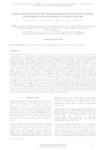Use este identificador para citar ou linkar para este item:
http://www.alice.cnptia.embrapa.br/alice/handle/doc/1067818| Título: | Geotechnologies for the characterization of specialty coffee environments of Mantiqueira de Minas in Brazil. |
| Autoria: | ALVES, H. M. R.  VIEIRA, T. G. C.   VOLPATO, M. M. L.   LACERDA, M. P. C.   BORÉM, F. M.   |
| Afiliação: | HELENA MARIA RAMOS ALVES, SAPC; EPAMIG SUL; EPAMIG SUL; UNB; UFLA. |
| Ano de publicação: | 2016 |
| Referência: | In: THE INTERNATIONAL SOCIETY FOR PHOTOGRAMMETRY AND REMOTE SENSING, 23., 2016, Prague, Czeach Republic. Proceedings... |
| Páginas: | p. 797-799 |
| Conteúdo: | Land-use/land-cover change (LUCC) is a major cause of environmental transformation. Distant drivers, often associated with emerging markets for specific products, are now being considered one of the main factors of LUCC and are gaining attention in land change science. Consumers show an increasing interest in local and quality food, certified for its origin and its environmental production standards. A kind of agricultural product certification, Geographic Indication, identifies a product as originating from a specific region where a given quality, reputation or characteristic is attributed to its geographical origin. Sustainable land use is potentially an indirect effect of Geographic Indication, as it requires better land management in order to preserve the natural resources associated with the unique characteristics of the certified product. Located in the southern region of the state of Minas Gerais in Brazil is the region of Mantiqueira de Minas, considered one of the most important regions for the production of specialty coffees in Brazil. In 2011, the region?s tradition and reputation were recognized with a Geographic Indication, the second given for coffee regions in the country. To explore the full potential of this area for producing coffees with higher quality and meet the growing demand of this new international market, which aggregates value at specialty coffees, it became fundamental to understand the coffee environments of the region, the ?terroirs? where these coffees are obtained. Geotechnology can give a significant contribution in filling this gap. This work is part of a research project that made a detailed characterization of the region?s coffee agroecosystems. Geotechnologies were employed to map the areas occupied by coffee plantations by using RapidEye satellite images and SPRING and ArcGIS software. All the segments of the environment were characterized and mapped in detail and the relations with coffee quality were evaluated. The results showed that coffee occupies approximately 8% of the region?s total area and is mostly distributed in the hilly areas with higher elevations. They also proved that specialty coffees are more likely to be obtained in altitudes above 1100 m, also being correlated to genotype and to the post-harvest methods employed. These results provide information that allows a better understanding of the factors involved in the expression of coffee quality. They also provide the scientific basis required for obtaining a new Geographic Indication for the Mantiqueira de Minas region, this time a Denomination of Origin (DO), which will certainly aggregate value to the specialty coffees produced in this unique region. |
| Thesagro: | Café Sensoriamento remoto |
| NAL Thesaurus: | Remote sensing |
| Palavras-chave: | Produção do café Brasil Minas Gerais Café especial Geotecnologia Gualidade do café Coffee |
| Tipo do material: | Artigo em anais e proceedings |
| Acesso: | openAccess |
| Aparece nas coleções: | Artigo em anais de congresso (SAPC)  |
Arquivos associados a este item:
| Arquivo | Descrição | Tamanho | Formato | |
|---|---|---|---|---|
| Geotechnologiesforthecharacterizationof.pdf | 621,19 kB | Adobe PDF |  Visualizar/Abrir |









